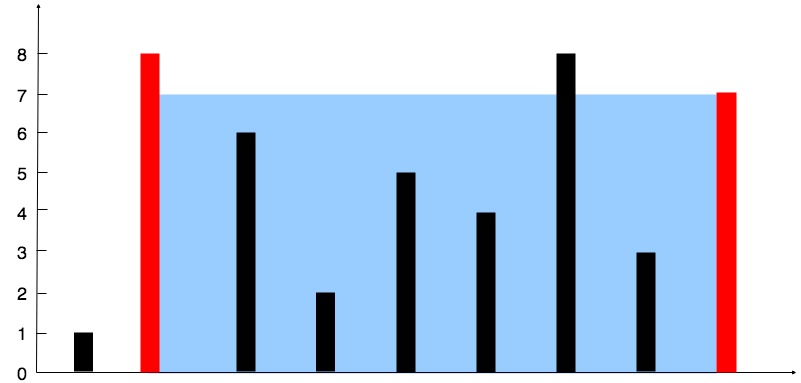You are given an integer array height of length n. There are n vertical lines drawn such that the two endpoints of the ith line are (i, 0) and (i, height[i]).
Find two lines that together with the x-axis form a container, such that the container contains the most water.
Return the maximum amount of water a container can store.
Notice that you may not slant the container.
Example 1:
Input: height = [1,8,6,2,5,4,8,3,7] Output: 49 Explanation: The above vertical lines are represented by array [1,8,6,2,5,4,8,3,7]. In this case, the max area of water (blue section) the container can contain is 49.
Example 2:
Input: height = [1,1] Output: 1
Constraints:
n == height.length2 <= n <= 1050 <= height[i] <= 104
给定一个长度为 n 的整数数组 height 。有 n 条垂线,第 i 条线的两个端点是 (i, 0) 和 (i, height[i]) 。
找出其中的两条线,使得它们与 x 轴共同构成的容器可以容纳最多的水。
返回容器可以储存的最大水量。
说明:你不能倾斜容器。
示例 1:
输入:[1,8,6,2,5,4,8,3,7] 输出:49 解释:图中垂直线代表输入数组 [1,8,6,2,5,4,8,3,7]。在此情况下,容器能够容纳水(表示为蓝色部分)的最大值为 49。
示例 2:
输入:height = [1,1] 输出:1
提示:
n == height.length2 <= n <= 1050 <= height[i] <= 104
| Language | Runtime | Memory | Submission Time |
|---|---|---|---|
| typescript | 80 ms | 50.1 MB | 2022/04/12 12:19 |
// two pointers
function maxArea(height: number[]): number {
let i = 0, j = height.length - 1;
let max = 0;
while (i < j) {
max = Math.max(Math.min(height[i], height[j]) * (j - i), max);
if (height[i] < height[j] && i < j) {
i++;
} else if (height[i] >= height[j] && i < j) {
j--;
}
}
return max;
};首指针从0开始,尾指针从数组末尾开始,计算这两个指针对应的盛水面积,然后移动较短边,继续计算盛水面积,直到首尾指针相碰即可。
// two pointers
function maxArea(height: number[]): number {
let i = 0, j = height.length - 1;
let max = 0;
while (i < j) {
max = Math.max(Math.min(height[i], height[j]) * (j - i), max);
if (height[i] < height[j] && i < j) {
i++;
} else if (height[i] >= height[j] && i < j) {
j--;
}
}
return max;
};



